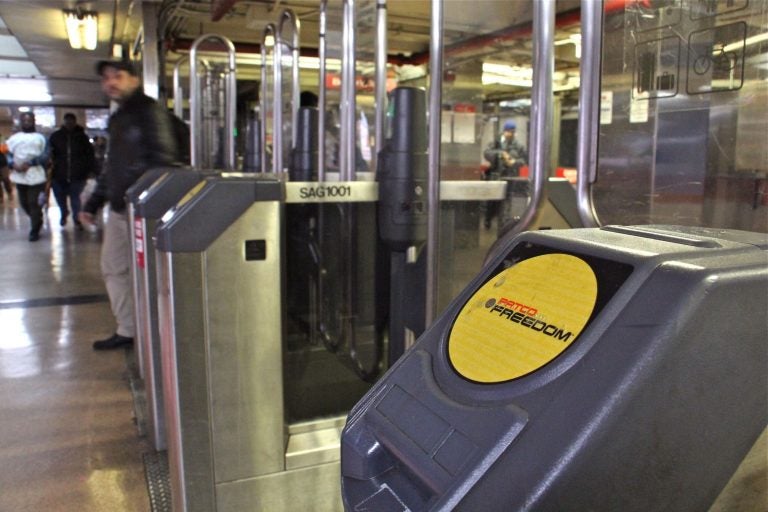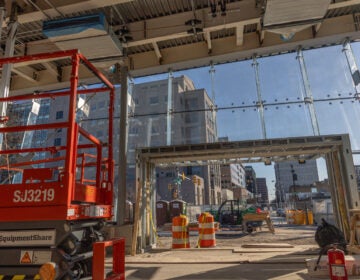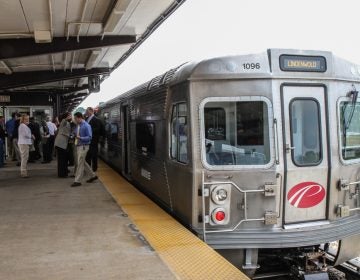No fare card, no problem: PATCO moves to let riders pay with their phones
Officials are still working out details of the new payment system, but phasing out the Freedom fare card is a possibility.

File photo: A PATCO fare gate at the 8th and Market stop. (Emma Lee/WHYY)
PATCO is planning a new fare payment system that will allow riders to use contactless cards and smartphones to pay for train rides.
“Technology is moving ahead and our customers are moving with it,” said PATCO president and CEO John Hanson. “We want to move along with our customers and with the technology.”
A proposal to bring farelines into compliance with global bank standards that support cards with smart chip technology will be presented to the board this month, said Hanson, who also leads the Delaware River Port Authority, the regional transportation agency that operates PATCO.
PATCO, pending board approval, expects to kick off a series of upgrades in March that’ll last over the next three years and cost about $6 million. The backend upgrades won’t affect riders in the short term.
Hanson said officials are still working out details on the new payment system, but phasing out the Freedom fare card that riders use currently is a possibility.
The train service moved to the Freedom card in 2007, giving riders access to tech that allows them to tap for payment — nearly 10 years before SEPTA Key entered customers’ hands.
Both systems are now moving onto the next thing: contactless payment.
SEPTA expects to launch contactless payment in 2020. Last year, the agency won board approval for a $4.4 million security upgrade to its card readers.
While riders have never been able to use Apple Pay or other smart pay systems before on SEPTA, PATCO experimented in 2011 with a “wave and pay” prepaid Visa card. The card, similar to SEPTA Key, with its debit option, was introduced as a pilot program and later expanded to allow riders to use other virtual cards. PATCO averaged about 3,000 contactless bank card transactions per month during the pilot, mostly for rail fare and parking transactions with a smaller number of non-PATCO retail purchases.
The pilot ended about a year later due to transaction costs that exceeded PATCO fares by 150%.
“Obviously, that’s not financially sustainable,” General Manager John Rink said in 2012. PATCO also reported customers were satisfied with the Freedom card.
“Not as many people had cards with chips in them…and the technology just hadn’t advanced,” Hanson said in a recent interview. “So we’re expecting a different reception, but we want to be able to be sure that we are appropriately catering to the preferences of our customers.”
PATCO bided their time as other transit agencies rolled out the technology. Officials specifically watched Miami-Dade County’s Metrorail transit system roll out their contactless payment program since they share the same fare system provider, Cubic Transportation Systems. Watching Miami-Dade’s process gave PATCO officials valuable insight into executing their own upgrade, Hanson said.
By the time PATCO riders can use Apple Pay or a new AMEX to board the train service that runs from Lindenwold, N.J. to Center City, the Freedom card will be about 16 years old, if everything goes according to plan.
Dave Monschien, 31, a longtime PATCO rider and Freedom cardholder, who commutes from New Jersey to Philadelphia, said “he was like, ‘hell yeah’” when PATCO introduced their flagship card. And he is still pleased to this day. An upgrade would be nice but “it’s already pretty convenient in my opinion.”
“I don’t see how it gets much more convenient because you still gotta pull something out of your pocket,” he said.
WHYY is your source for fact-based, in-depth journalism and information. As a nonprofit organization, we rely on financial support from readers like you. Please give today.






